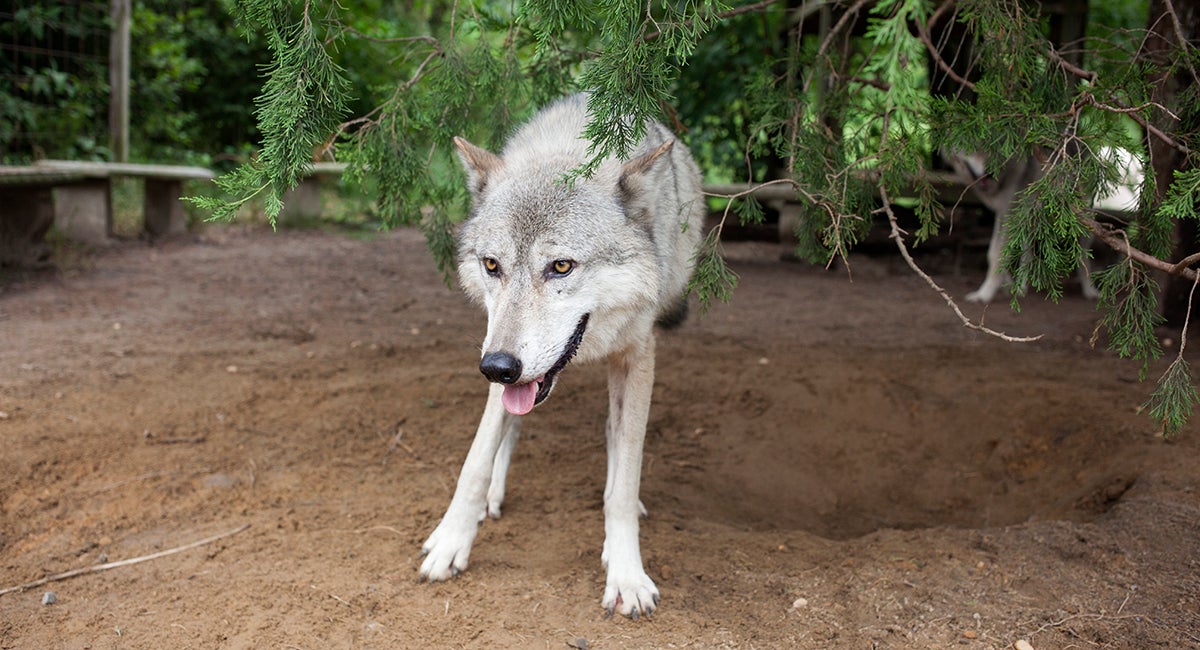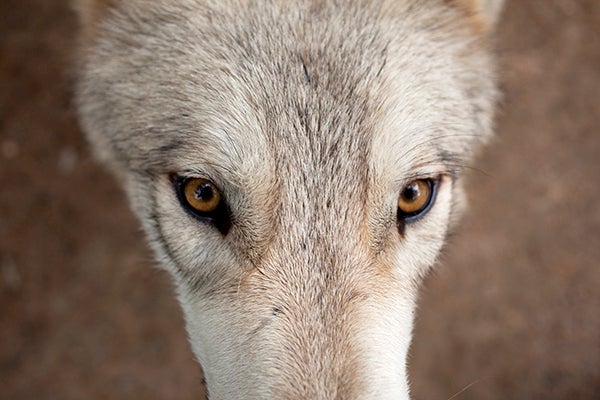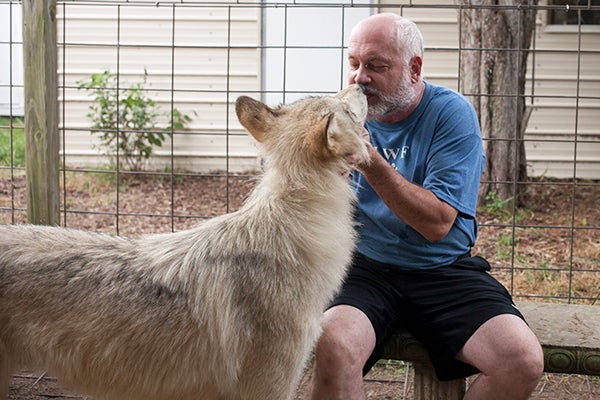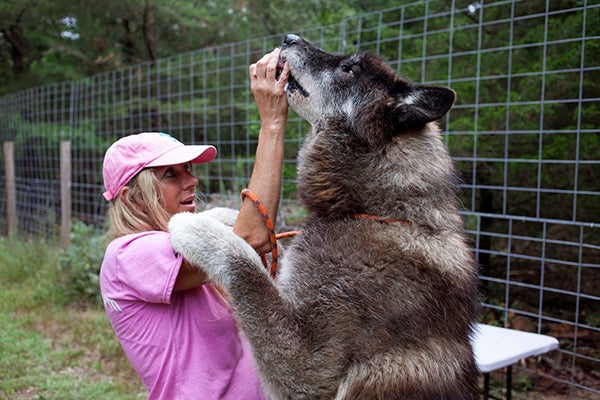Wolfdog hybrids make for high-maintenance, myth-making pets
Listen
A wolfdog hybrid at Howling Woods Farm
On a recent sunny afternoon, a handful of volunteers led a tour group around Howling Woods Farm, in rural New Jersey. The Farm is a rescue facility for wolfdogs – hybrids bred from wolves and dogs – and home to just under 20 animals.
The visitors’ oohs and aahs belied equal parts awe at the yellow-eyed, wolfy creatures and uneasiness at their strength. When one growled at an unwelcome hug from a visitor, a woman conceded that the powerful teeth it bared were “scary to look at,” but she couldn’t seem to take her eyes off of it.
Michelle Persiano, one of the volunteers, stood by, eyeing the wolfdogs with affection. She’s drawn to them because she’s always loved wolves. “They’re in charge, they’re regal, they’re very majestic, almost mysterious,” she said.

One of the high content wolfdogs at Howling Woods Farm. (Irina Zhorov/The Pulse)
She wore a necklace with a pendant, featuring a handsome wolfdog named Naiche, resplendent in his winter coat. She said she always wears something Naiche. She even has a hat woven from his fur. “It’s pretty bad when I go to a doctor and the first thing they say to me is ‘How’s Samson and Naiche today?’ Not me,” she said.
Naiche and Samson are both high-content wolfdogs, which means they have a lot of wolf in them. They’re Persiano’s favorites. She doesn’t have any wolfdogs of her own, but she’s at the Farm five days a week and is clearly smitten. A lot of people get wolfdogs because, like Persiano, they’ve always loved wolves. The animals hold a mythical place in our cultural history.
But wolfdogs are illegal to keep in many states (at least in part because there are no approved rabies vaccines for them), or require special permissions. They’re expensive – a puppy can cost thousands of dollars. And they’re high-maintenance pets.

Michael Hodanish, owner of the Howling Woods Farm wolfdog rescue, cuddles with one of the high content wolfdogs that lives at the facility. (Irina Zhorov/The Pulse)
Michael Hodanish, who owns the Farm, said there’s another reason people still get them.
“Um, mostly ego,” he said. “They want to tell people ‘I have a wolf.’”
A lot of work
Despite the impressive teeth, Hodanish said well-cared-for wolfdogs aren’t dangerous. But they’re a lot of work.
“They’re much more independent, they’re much more difficult to have as pets,” he said. “The higher content animals, they don’t like being confined, they don’t like being inside a home, if you bring them inside a house, they might get anxious.”
They can become very destructive indoors, so they need an outdoor pen, with tall fences. They’re pack animals, so they don’t do well without other canine companions. For food, they eat raw meat, not kibble. Lots of raw meat (the wolfdogs at the Farm consume about 400 pounds per week). And they’re not good guard dogs; they expect the owner, their alpha, to protect them.
When people realize all this about their wolfdogs, they sometimes abandon them. Hodanish takes them in when he has room. The animals at the Farm come from all over the country.
He broke away from the tour and walked along tall, heavy-duty pens with beautiful, lupine dogs in them, narrating their case histories. He paused at one named Winona, who was found on the street in Queens, New York. “It happens all the time,” he said. “I’m sure the breeder said, ‘She’ll be fine, she’ll be a good pet for you.’” After she was picked up, no one came forward to claim her, in part, Hodanish thinks, because it’s illegal to keep wolfdogs in New York.
Unpredictable hybrids
Most of the dogs at Howling Woods Farm have some wolf in them, but they act and look vastly different. Some approach the fences like a dog would. Others stay away. Persiano said it took her months to get Naiche to trust her. Some have the lean legs of a wolf, others have thicker frames of dogs like malamutes.

Michelle Persiano, a volunteer at Howling Woods Farm, on a walk with Samson. Samson has wolf in him, but Persiano says he gets his size from his dog lineage. (Irina Zhorov/The Pulse)
These clearly identifiable differences in wolves and dogs initially made scientists classify them as a different species, said biologist Heidi Parker. She researches the dog genome.
“Taxonomy used to be based on physical characteristics and where they lived in the wild, whether they’d ever be in contact with each other, whether or not their mating habits coincided in such a way that they would regularly interact and interbreed. And a lot of these things sort of set dogs apart,” she said.
When technology made mapping the animals’ genomes possible, biologists found that dog and wolf DNA are actually very similar. Just about one percent of the genome is different between a domestic dog, canis lupus familiaris, and the wolf, canis lupus.
Dogs were reclassified as a subspecies of the wolf, a nod to their evolutionary origins. But that one percent is the difference between a pet and a wild animal.
Imagine, said Parker, there are a hundred different genes that differentiate dog-wolf behaviors and appearance. When the genes are mixed, the results are unpredictable. “You would have a chance at every one of these 100 genes of getting randomly a dog or wolf version. But you have no idea which ones are the ones that show up in your offspring. It’d be kind of like flipping a coin.”
You could end up with something that acts like a dog but looks like a wolf. Or you could get a wolfdog with a very wolfy personality, which makes for a high-maintenance pet, especially in urban areas.
Hodanish says that’s often when people abandon them.
So the wolfdogs straddle an odd lineage, of unfettered wildness and domesticated neediness, a forced and unsettling combination that makes them an ill fit in both the wolf and dog worlds.
As the tour wound down, the volunteers started to howl, to make the wolfdogs sing. All the dogs joined in. But one, named Bandit, couldn’t produce a respectable howl. He raised his muzzle skyward but all that came out was a raspy whine. He’s mostly dog, and not all dogs can vocalize a howl. But something in him still made him want to join in with his pack.
WHYY is your source for fact-based, in-depth journalism and information. As a nonprofit organization, we rely on financial support from readers like you. Please give today.



